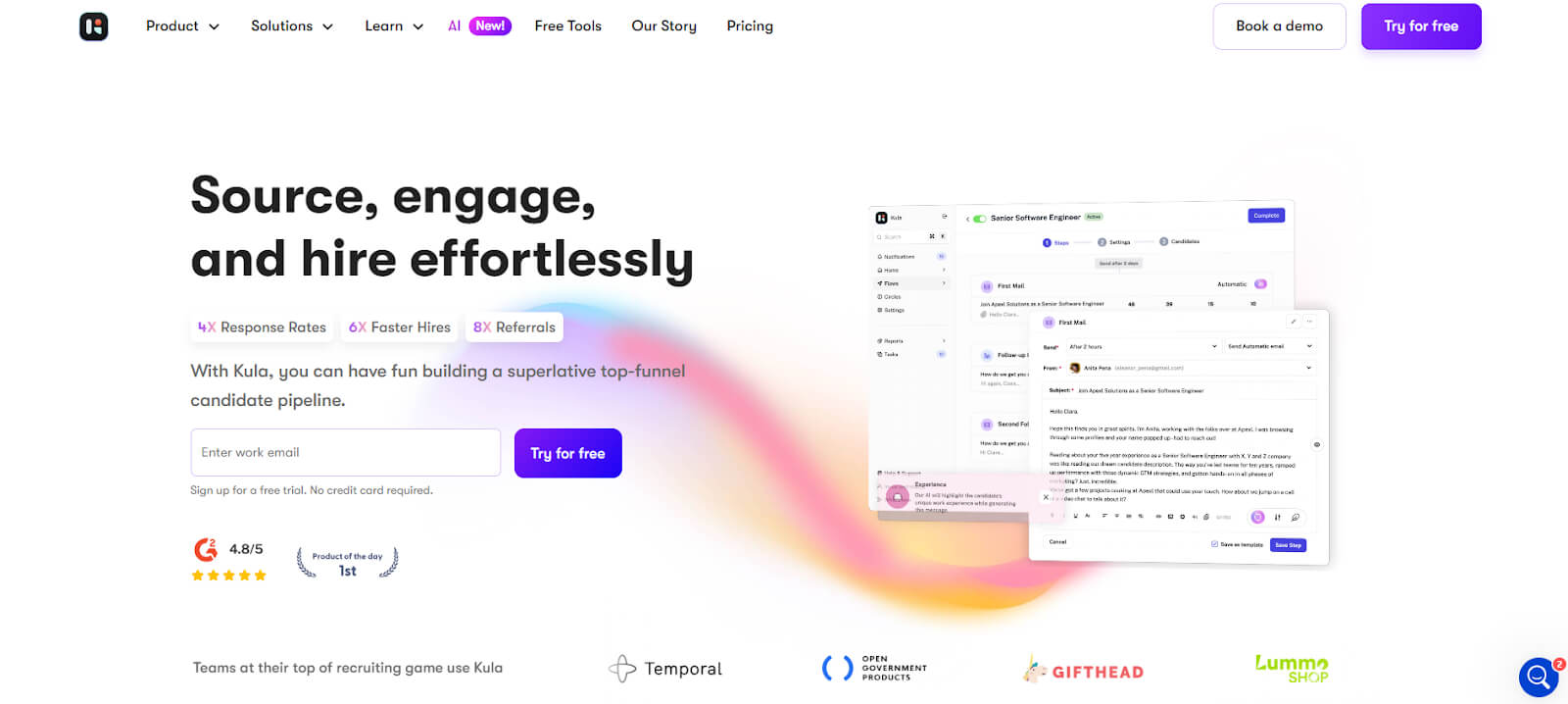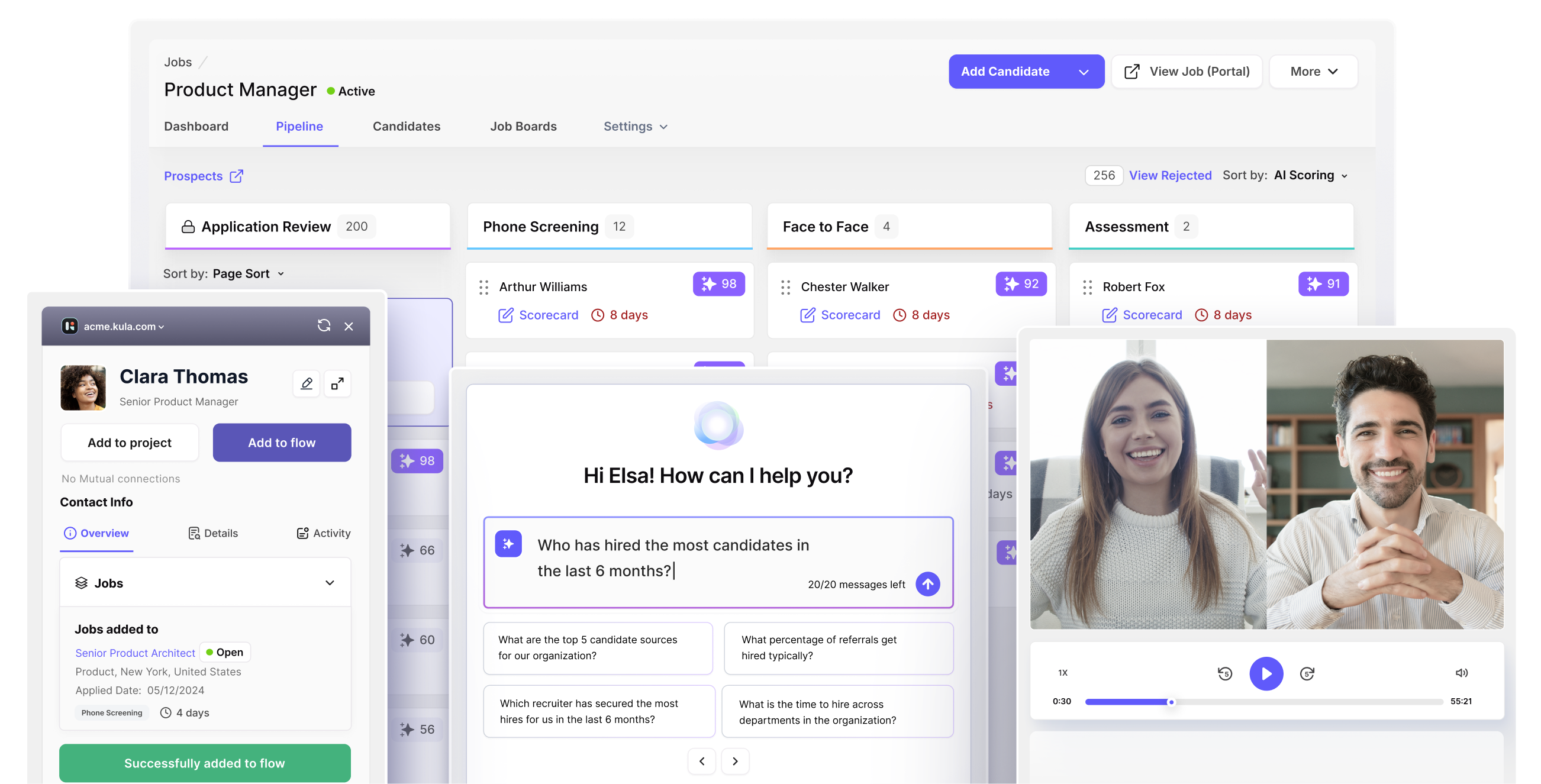Book a 30-minute demo and learn how Kula can help you hire faster and smarter with AI and automation
State of Internal Recruiting 2021 found that 75% of organizations conduct at least some form of internal recruitment because it:
- Is time and cost-effective
- Boosts employee morale
- Reduces bad hire risks.
But how does it work? Are there any limitations? And how do you create an internal recruitment process for your organization?
In this article, we address these with our extensive guide on internal recruitment.
What is internal recruitment?
Internal recruitment involves considering current employees to fill vacancies within an organization. Unlike external talent acquisition, this hiring process focuses on a company’s internal talent.
It involves assessing existing talent from different departments, identifying the right people internally, and offering them positions to promote career growth. These opportunities are typically advertised through the company intranet and emails.
Internal recruiting is cost-effective, improves employee morale, and preserves organizational knowledge. Offering internal mobility also improves employee advocacy and elevates the employer brand.
Types of internal recruitment
The primary types of internal recruitment are:
Promotions
The most sought-after internal recruiting process is promotions. This refers to offering employees a superior position and moving them up the organizational hierarchy. It is one of the most common practices while filling a higher-level position since internal talent already knows the company’s work structure.
Transfer
This type of internal recruitment moves an employee from one position to another without changing their rank or level of responsibilities. They may be transferred to a new team, department, or branch.
Transfers are especially effective because they let a company move employees where they can add the most value. It helps employees realize their true potential and achieve better job satisfaction.
Employee referral
In this type of internal recruitment, companies hire talent referred by current employees. They may offer bonuses based on successful referrals.
Temporary to permanent
This type of internal recruitment offers part-time, contractual, and temporary employees full-time positions.
How does internal recruitment work?
The specifics of internal recruitment vary between companies. However, here’s how it usually works:
Identify job openings
Companies audit the current workforce and pinpoint skill gaps. They consider upcoming retirement and churn to anticipate future vacancies. The next step is to analyze whether recruiting someone internally will serve the positions. Organizations also consider filling the leadership openings with current experienced employees.
Post jobs internally
Once companies identify suitable positions, they communicate the opportunities. The recruitment team posts the openings with detailed job descriptions on the internal job board and company intranet. Some organizations also use automated emails to notify employees of upcoming vacancies.
Employees apply internally
If qualifications and skills match the post, employees apply by submitting their resumes, SOPs, and references from team leaders and department heads.
Screen resumes using ATS
Use an ATS like Kula to store applications, screen resumes, and shortlist candidates who fit the requirements based on:
- Experience
- Skillset
- Performance
- Contribution to the company
- Developmental pace
Conduct interviews
After shortlisting applicants, recruiters schedule interviews using an ATS based on the candidate’s and the recruiter’s availability. They get notifications and reminders accordingly.
Select the right candidate and offer
Once the interviews are conducted, the recruiting panel selects the right candidate for the position and makes an offer.
Share feedback with rejected candidates
Send the rejected candidates feedback pinpointing areas of improvement to maintain complete transparency and avoid any potential resentment.
Advantages of internal recruitment
Faster hiring process
External hiring is time-consuming and requires weeks to source eligible candidates, verify references, and run extensive background checks. Even after an offer is made, ghosting is quite common.
In internal recruitment, you already know the candidates and their capabilities. It doesn’t require lengthy resume screening, reference checks, or onboarding. This way, you can fill vacancies with competent people in less time.
Saves costs
Internal recruiting lets you reduce costs associated with lengthy screenings and bad hires. You don’t have to advertise openings across different job boards and spend on multiple interview rounds for applicants.
Often, companies let go of new hires who aren’t a right fit, losing money. Since the candidates are your current employees, they already work well with your work culture, reducing the cost of bad hires.
Boosts morale and motivation
With internal recruitment, you can cater to an employee’s need for growth opportunities and better salaries. It offers your loyal employees professional growth, better pay, and status by moving up the hierarchy. They feel appreciated, boosting morale and motivation to do better.
Preservation of company knowledge
Internal recruiting preserves the knowledge of existing employees. As their skills develop with time, promotions let companies use this knowledge growth for business benefits.
Reduced risk and improved performance
There is no guarantee that an external hire will adopt your methods well. But your current employees have proven their competency. Offering them opportunities reduces the risk of sudden churn and keeps the workflow and performance intact.
Disadvantages of internal recruitment
Limited candidate pool
Exclusively hiring internal candidates for vacancies limits the candidate pool and your access to diverse talent. You may overlook professionals with better skills and experiences.
Lack of fresh perspectives
External employees often bring fresh perspectives and diverse experiences necessary for constant innovation. Filling strategic positions solely through internal recruitment may not challenge the status quo needed for continuous growth.
Potential for resentment among employees
Rejected employees may feel resentment towards their promoted colleagues. This hampers the work environment and may reduce synergy.
Internal politics may influence decisions
Internal politics and favoritism could influence decisions. The best candidates may get overlooked, compromising the hiring process’s integrity.
Talent gaps may persist
Skills that an existing employee needs versus the skills they possess may lead to substandard task execution. So, exclusively hiring internally may backfire.
Developing an effective internal recruitment process
Communicate open roles clearly
Create detailed job posts and make them easily accessible. Share the qualifications, skills, and experience needed for the position. Inform employees about the opportunities through internal notifications and newsletters.
Maintain process transparency
Clarify the selection process early, including interview rounds, screening criteria, and DE&I standards. Ensure the candidate gets timely reports and feedback on their progress. Once you select a candidate, inform the workforce why they are the best fit.
Keep a fair selection criteria
Specify fair selection criteria for the recruiters and candidates. Use standardized assessments for external and internal hiring that don’t disadvantage any group. Create diverse panels representing different perspectives. You must also train your team on best practices and ways to overcome unconscious bias.
Provide training and mentorship
Train and mentor candidates to hone their skills through webinars, workshops, and expert discussions. Ask the leadership to mentor candidates on professional growth and internal mobility.
Share constructive feedback for rejected candidates
Offer timely feedback with constructive insights to the rejected candidates so they know where to improve to climb up the ladder.
Balance between internal and external recruitment
Finally, ensure your internal and external recruitment strategies complement each other. For example, you can seek external candidates for entry-level roles and offer internal mobility to fill the leadership roles.
Would internal recruitment benefit your company?
Yes, internal recruitment can benefit your company by:
- Fostering employee satisfaction, morale, and loyalty
- Reducing hiring costs
- Facilitating quicker and quality hiring
- Minimizing hiring risks
However, it shouldn’t be your only hiring framework since it may compromise workforce diversity and limit the fresher perspectives that external candidates can bring. So, balance your internal recruitment strategies with a well-planned external recruitment process.
Internal recruitment best practices
Regularly review talent
Keep high-potential employees on your radar through regular talent reviews. Use performance management tools to evaluate their development, agility, and diligence. This way, you will know exactly which employees will be the best fit for any urgent vacancies.
Use an ATS to streamline the process
Invest in a scalable ATS that goes beyond passive candidate sourcing. It should maintain employee profiles with tangible performance and developmental insights. Use advanced search functions and AI-candidate sourcing and matching to identify the best internal talent for specific vacancies.
Some other ATS features that streamline internal recruitment include:
- Application submission and tracking
- Automated screening and evaluation
- Seamless feedback delivery for transparency

With Kula, you get all these features and more to streamline internal recruitment. We offer AI-powered candidate matching to get the most promising employees in seconds. Our platform also has an application tracker, advanced filters, and an interview scheduler. Employees can easily apply for promotion opportunities and schedule interviews according to availability.
Encourage employee referrals
Tap into your workforce’s network by motivating employee referrals. Besides spectacular candidate engagement policies, highlight how their referrals contribute to the company’s growth. Make it worth their while with incentives like bonuses and gifts.

You can use an ATS to automate the referral programs as well. For example, Kula Circles combines your entire employee network and creates high-quality talent pools.
Adhere to DEI standards
Lay out clear DEI standards to create an inclusive internal mobility framework and uphold your commitment to diversity. This lets you bypass favoritism, bias, and discrimination, and eliminate resentment. Follow these steps:
- Build diverse screening panels with people of color, and women employees to mitigate bias and implement diverse perspectives in internal mobility
- Use inclusive language in your job descriptions
- Reserve specific vacancies for employees from underrepresented groups
Run employee development programs
Bring out the best in your employees with personalized L&D programs. Understand their ambition, passion, and professional desires and design modules accordingly. Offer training and courses that develop their strengths and overcome weaknesses.






















